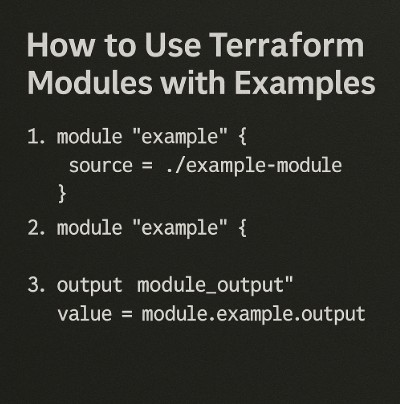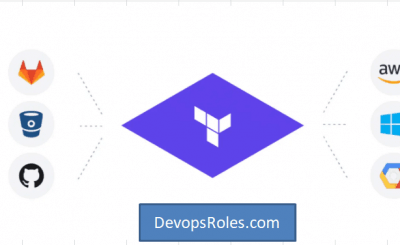Are you struggling to manage the growing complexity of your infrastructure code? Do you find yourself repeating the same configurations across multiple projects? The solution lies in leveraging the power of Terraform modules. This comprehensive guide provides practical Terraform modules examples to help you streamline your workflow, improve code reusability, and enhance the overall maintainability of your infrastructure. We’ll cover everything from basic module creation to advanced techniques, empowering you to write cleaner, more efficient Terraform code. Learning to effectively utilize Terraform modules examples is a crucial step towards becoming a proficient Terraform user.
Table of Contents
Understanding Terraform Modules
Terraform modules are reusable packages of Terraform configurations. They encapsulate infrastructure components, allowing you to define and manage them as self-contained units. This promotes modularity, reduces redundancy, and significantly improves the organization of your codebase. Think of modules as functions in programming – they take input variables, perform specific tasks, and produce output values. By using modules, you can abstract away implementation details, making your code more readable and easier to maintain.
Benefits of Using Terraform Modules
- Improved Reusability: Avoid writing the same code repeatedly. Create a module once and use it across multiple projects.
- Enhanced Maintainability: Easier to update and maintain a single module than multiple instances of similar code.
- Increased Readability: Modules encapsulate complexity, making your main Terraform code cleaner and easier to understand.
- Better Organization: Modules help structure your infrastructure code into logical units, promoting better organization and collaboration.
- Version Control: Easier to version control and manage changes in a modularized codebase.
Creating Your First Terraform Module
Let’s start with a simple example: creating a module to deploy a virtual machine in AWS. This will serve as a foundation for understanding the structure and functionality of Terraform modules examples.
Module Structure
A Terraform module typically consists of the following files:
main.tf: The main Terraform configuration file for the module.variables.tf: Defines the input variables for the module.outputs.tf: Defines the output values that the module produces.
Code Example: AWS EC2 Instance Module
variables.tf
variable "instance_type" {
type = string
default = "t2.micro"
}
variable "ami_id" {
type = string
}
main.tf
resource "aws_instance" "example" {
ami = var.ami_id
instance_type = var.instance_type
}
outputs.tf
output "instance_id" {
value = aws_instance.example.id
}
This simple module allows you to deploy an AWS EC2 instance. You can specify the instance type and AMI ID as input variables. The module then outputs the ID of the created instance.
Advanced Terraform Modules Examples
Now let’s explore some more advanced Terraform modules examples. This section will cover more complex scenarios to solidify your understanding.
Module for a Complete Web Application Deployment
This example demonstrates how to create a more complex module, encompassing multiple resources required for a web application.
- VPC Module: Create a virtual private cloud (VPC) with subnets, internet gateway, and route tables.
- EC2 Instance Module: Deploy an EC2 instance within the VPC.
- Security Group Module: Define security groups to control network access to the EC2 instance.
- Load Balancer Module (Optional): Implement a load balancer for high availability.
Each of these components could be its own module, showcasing the power of modularization. This approach promotes reusability and simplifies the management of complex infrastructures.
Using Modules with Remote State Backend
For larger projects or collaborative environments, it’s best practice to use a remote state backend. This allows multiple users to work on the same infrastructure code without conflicts. Modules seamlessly integrate with remote state backends like S3 or Azure Storage.
Practical Application of Terraform Modules: Real-World Scenarios
Let’s explore how Terraform modules examples translate into solving real-world infrastructure challenges.
Scenario 1: Multi-environment Deployments
You need to deploy your application to multiple environments (development, staging, production). Modules help significantly in this scenario. You can define a single module for your application and then reuse it in all environments, simply changing the input variables for each environment (e.g., different AMI IDs, instance types, and VPC configurations).
Let’s say you have a set of shared services, such as a database or a message queue, that are used by multiple applications. You can encapsulate these shared services into modules and reuse them across different projects.
Scenario 3: Infrastructure as Code (IaC) for Microservices
If you’re building a microservice architecture, you can use modules to deploy individual microservices. Each microservice can have its own module, making it easier to manage and scale your application independently.
Frequently Asked Questions
You can share Terraform modules using a variety of methods, including:
- Private Git repositories: Ideal for internal use within your organization.
- Public Git repositories (e.g., GitHub): Suitable for sharing modules publicly.
- Terraform Registry: A central repository for sharing and discovering Terraform modules.
Q2: How do I manage dependencies between Terraform modules?
Terraform modules can depend on other modules. This is done by specifying the source of the dependency module in the module block. Terraform will automatically download and install the required modules.
Q3: What are the best practices for writing Terraform modules?
Here are some best practices:
- Use clear and descriptive names: This improves readability and maintainability.
- Validate input variables: Prevent unexpected behavior by validating the inputs to your modules.
- Document your modules thoroughly: Include clear documentation to explain how to use your modules.
- Follow the principle of least privilege: Grant only necessary permissions to your modules.
Q4: Can I use Terraform modules with different cloud providers?
Yes, you can create Terraform modules that work with multiple cloud providers. You would likely need to use conditional logic (e.g., `count`, `for_each`) or separate modules to handle provider-specific configurations.

Conclusion
This guide has demonstrated the practical benefits of using Terraform modules, providing numerous Terraform modules examples across different complexity levels. By mastering the art of creating and using Terraform modules, you can significantly improve the efficiency, reusability, and maintainability of your infrastructure code.
Remember to leverage the power of modularization to build robust, scalable, and easily managed infrastructures. Start experimenting with the Terraform modules examples provided here, and gradually build up your knowledge to create more complex and sophisticated modules for your infrastructure projects. Remember that well-structured Terraform modules examples are a key ingredient to efficient and maintainable infrastructure as code. Thank you for reading the DevopsRoles page!
For further reading, consult the official Terraform documentation: https://www.terraform.io/docs/modules/index.html and explore community-contributed modules on the Terraform Registry: https://registry.terraform.io/
